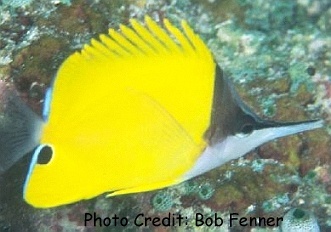
By Bob Goemans

Not Reef Tank Suitable
Likely Fish-Only Tank Suitable
Range: Indo-Pacific Ocean: Red Sea and eastern coast of Africa to Hawaii, and also the Eastern Pacific: Baja California coastline to the Galapagos and Revillagigedo Islands.
Size: 8.5 inches (22 cm)
Natural Environment: This extremely widespread species inhabits exposed outer reefs and lagoons with abundant coral growths and areas that have numerous caves and ledges. Feeds on urchins, soft and hard corals, hydroids, crustaceans, and worms at depths between 10 to about 480 feet (3 – 140 m). Lives singly, in loose pairs, or in trios.
General Husbandry: This highly attractive and very hardy species has a brightly colored yellow body with its upper face area black and its lower half off-white. It’s dorsal, anal and pelvic fins are yellow, with the tail and pectoral fins clear. There’s also a black false eyespot on the upper aft edge of the anal fin. Its biggest attraction is its elongated, needle-nose-like snout, which is used for searching out prey in crevices and cracks.
Adapts quite easily to aquarium life in larger reef style aquariums or peaceful fish-only community aquariums, especially those with lots a rocky caves and ledges to explore. A meaty diet of live fortified brine shrimp, black worms (Lumbriculus variegatus), and/or various frozen meaty foods such as mysis are usually eagerly accepted and should be offered several times daily.
Even though it can be maintained in reef aquariums, its not fully trustworthy as its been known to nip at soft and stony corals and occasionally clam mantles. It’s also a good consumer of Aiptasia anemones, however its appetite for them declines if there is a supply of more suitable/preferred foods. It may also consume small decorative tubeworms and other useful small worms.
Even though usually quite easy to get feeding, should there be some difficulty, recommend supplying live foods such as feeder shrimp and bloodworms. Also, small human consumption clams/black mussels purchased in local grocery stores and placed on the half-shell in the aquarium will help entice it to begin feeding. Over time, frozen foods like mysis and brine shrimp will be more readily accepted.
This is one of the more distinctive species of butterflyfishes and difficult to confuse with others in its family. Often a great addition to most reef aquariums when its needs are met.
Taxonomy:
Order: Perciformes
Suborder: Percoidei
Family: Chaetodontidae
Genus: Forcipiger
FYI: Preferably maintained without others in the same genus, except as a male-female pair, as they can become quite territorial and battle others for territorial rights.
Pressing some soft foods into openings/crevices on a piece of old dead coral skeleton can sometimes encourage finicky eaters to begin feeding.
Experience Level: Beginner
Temperament: Peaceful
Diet: Carnivore
Coral Safe: Caution advised
Invertebrate Safe: Caution advised
Acclimation Time: 30 minutes+
Aquarium Environment: Reef aquarium (see above) and fish-only aquarium.
Tankmates: Peaceful or non-aggressive
Minimum Tank Size: 75 gallons
Temperature Range: 70 - 82°F (21 – 27°C).
Specific Gravity: 1.020-1.026
pH: 8.0 - 8.5
